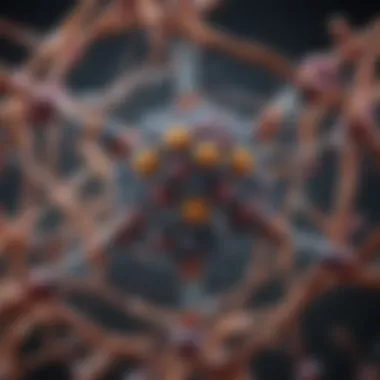Understanding RET-Driven Cancers: Mechanisms and Advances


Intro
The role of genetic mutations in cancer is a burgeoning field of study. Amongst these mutations, those linked to the RET gene have increasingly caught the attention of scientists and oncologists alike. The RET oncogene is primarily known for its association with neuroendocrine tumors, particularly medullary thyroid carcinoma and multiple endocrine neoplasia. However, the landscape of RET-driven cancers extends far beyond these well-known entities. This piece aims to bridge the knowledge gap surrounding RET gene alterations, their underlying mechanisms, and the proliferation of targeted therapies that promise to change the course of treatment for affected individuals.
Investigating RET mutations offers valuable insights not only into tumorigenesis but also into patient prognosis and the development of tailored management strategies. All in all, a deeper comprehension of RET’s role could provide vital clues for oncological interventions, leading to improved patient outcomes and reduced morbidity.
Key Findings
Summary of the main results
Research has unearthed several key findings regarding the role of the RET gene in the development and progression of various malignancies. It has been established that alterations in RET can lead to constitutive activation of signaling pathways responsible for cell proliferation and survival. Here are some critical observations from recent studies:
- RET gene mutations are frequently implicated in multiple cancer types, including
- The frequency and types of RET mutations can vary significantly among different cancers. For example, the presence of a RET fusion gene is notably prevalent in lung cancers, whereas point mutations are more frequently observed in thyroid cancers.
- With advancements in sequencing technologies, researchers have been able to identify novel RET mutations and their potential contributions to tumor biology, paving the way for more effective diagnostic methods.
- Medullary thyroid carcinoma
- Papillary thyroid carcinoma
- Non-small cell lung cancer
- Colorectal cancer
- Neuroblastoma
This body of research not only clarifies RET's role in carcinogenesis but also highlights the need for continuous exploration to unearth the complexities of RET-altered tumors.
Significance of findings within the scientific community
The revelations surrounding RET mutations have significant implications within the scientific community. The discovery of RET’s involvement in diverse cancer types encourages ongoing collaborative research aimed at developing targeted therapies. Additionally, the identification of RET as a distinct biomarker opens new avenues for personalized treatment approaches.
“Understanding RET pathways not only advances cancer biology but also has the potential to inform more effective treatment protocols for affected patients.”
Adaptations in clinical practices will likely follow as healthcare professionals become more informed about the genetic underpinnings of their patients' tumors.
Implications of the Research
Applications of findings in real-world scenarios
The knowledge gained from RET research isn’t just academic; it holds practical applications. For instance, the development of selective RET inhibitors, such as selpercatinib and pralsetinib, demonstrates the tangible progression of research into effective clinical treatments.
In therapeutic settings, these advancements offer:
- Improved patient outcomes: By targeting specific mutations, treatments can lead to better survival rates.
- Reduced side effects: Precision medicine often results in fewer adverse drug reactions since therapies can be tailored to individual genetic profiles.
Potential impact on future research directions
Looking ahead, the RET field is ripe for innovation. Future research may focus on:
- Elucidating the mechanisms of resistance to existing therapies, potentially leading to combination treatments that improve efficacy.
- Identifying other molecular pathways that intersect with RET mutations to expand the understanding of tumor biology comprehensively.
- Conducting larger clinical trials that adequately represent diverse populations to ensure equitable access to breakthroughs in targeted therapies.
In essence, delving into the complexities of RET-driven cancers not only fuels a deeper understanding of the biology of cancer but also lays the groundwork for advanced therapeutic modalities. The implications are wide-ranging, promising to empower both patients and healthcare providers as they navigate the fields of diagnostic and therapeutic oncology.
Overview of RET-Driven Cancers
The exploration of RET-driven cancers stands at the crossroads of genetics and oncology, a nexus that has garnered attention because of its profound implications for both diagnosis and treatment. RET, a gene known for its crucial role in cellular signaling, often comes under fire when mutations or alterations trigger oncogenesis. The significance of RET mutations leaps into sharper focus as we come to terms with their connection to various cancers—this is no mere footnote in cancer biology, but rather an important chapter that sheds light on patient outcomes, therapeutic strategies, and future research directions.
Understanding the landscape of RET-driven cancers means appreciating not only the gene's biological function but also how its alterations pave the way for malignancy. In this context, the depth of investigation we undertake can radically influence patient care protocols and informs the development of innovative treatment modalities.
Definition and Significance
RET, or rearranged during transfection, is a proto-oncogene that encodes a receptor tyrosine kinase integral to processes such as neuronal development and kidney function. When the RET gene is altered—through mutations, rearrangements, or other genetic aberrations—it can lead to a cascade of cellular events that promote uncontrolled proliferation and survival of cancer cells. This is significant because:
- Diversity of Cancers: RET mutations are implicated in a variety of cancer types, including medullary thyroid carcinoma, non-small cell lung cancer, and papillary thyroid carcinoma. Understanding these associations can help identify populations at risk, guide early diagnosis, and tailor specific therapies.
- Therapeutic Targets: RET alterations provide a targetable mechanism in cancer therapy. For example, small molecules that inhibit RET signaling pathways can offer potentially effective treatments that might not be available for other cancers.
- Diagnostic Tools: The challenge of detecting RET mutations necessitates advancements in diagnostics, including next-generation sequencing. These technologies can improve the accuracy of identifying aberrations, which is essential for appropriate treatment decisions.
Historical Context
The journey of RET-driven cancer research traces back several decades, evolving concurrently with advancements in molecular biology. The discovery of the RET gene itself in the late 1980s marked the inception of a series of studies highlighting its role in developing certain cancers.


Initially, the focus was relatively narrow, primarily addressing medullary thyroid carcinoma, which was one of the first cancers directly associated with RET mutations. As research progressed, the array of cancers linked to RET expanded significantly, with findings about its role in lung and thyroid cancers garnering substantial attention in the early 2000s.
Events such as the Human Genome Project catapulted this field forward, allowing for a deeper understanding of genetic mutations in cancer. More recently, the advent of personalized medicine and targeted therapies has accelerated research, leading to an essential shift in treatment paradigms.
Each of these elements contributes to a richer understanding of RET-driven cancers, forging paths not just for academia but also for clinical practice in terms of aligning treatment strategies with genetic makeup.
"Understanding RET-driven cancers isn't solely about understanding RET—it's about unraveling the tapestry of cancer itself"
Throughout this exploration, the stakes are notably high, hinting at transformative possibilities that lie ahead—not just for individuals impacted by these cancers but for the entire realm of oncological treatment.
Molecular Mechanisms of RET Activation
Understanding the molecular mechanisms of RET activation is crucial for deciphering its role in various cancers. RET (Rearranged during Transfection) is a proto-oncogene involved in crucial signaling pathways. When activated, it can potentially lead to uncontrolled cell division, contributing to tumor progression. This knowledge paves the way for targeted therapies and diagnostics, highlighting the importance of clear understanding of how RET operates at a molecular level.
RET Gene Structure and Function
The RET gene is located on chromosome 10 and encodes a receptor tyrosine kinase. Its structure includes multiple domains that play specific roles in cellular signaling. Generally, it consists of:
- Extracellular domain: This part of the gene interacts with various ligands, essential for triggering its activity.
- Transmembrane domain: This segment anchors the receptor in the cell membrane, facilitating communication between the inside of the cell and the extracellular environment.
- Intracellular domain: This rear portion contains the tyrosine kinase domain that, once activated, can transmit signals downstream affecting other pathways involved in cell growth, differentiation, and survival.
Due to its position in major signaling networks, RET serves as a fundamental player not only in normal cell function but also in oncogenesis when altered.
Mutational Profiles in RET
Mutations in the RET gene can manifest in several ways, ranging from point mutations to larger structural changes such as fusions or deletions. Some of the common types of mutations include:
- Point mutations: These can lead to constitutive activation of RET, resulting in aberrant signaling.
- Gene fusions: Occur when RET merges with another gene, which often yields a hybrid protein that can drive cancer progression. A classic example is the RET/PTC fusion, frequently seen in papillary thyroid carcinoma.
- Copy number variations: These alterations may also influence the degree of RET expression and dysfunction, further escalating the risk for malignancy.
Examining these mutational profiles not only aids in understanding individual cancer pathologies but also informs tailored treatment strategies.
Signaling Pathways Involved
Upon activation, the RET receptor influences multiple signaling cascades that can lead to oncogenesis. Some of the key pathways include:
- MAPK pathway: Mediates cellular processes such as proliferation and survival.
- PI3K/Akt pathway: Involved in survival signaling, promoting cell survival and anti-apoptotic mechanisms.
- PLC-γ pathway: This pathway enhances cellular functions such as migration and invasion.
These pathways can often intersect with other cellular signals, forming a complex network that supports tumor growth and metastasis. Understanding how RET activates these pathways can lead to better targeted therapies that disrupt these malignant signals while preserving normal cellular functions.
"Exploring RET activation mechanisms illuminates both the devastating effects it can have on cellular behavior and the therapeutic opportunities that may arise from a better understanding of its pathways."
The depth of knowledge around RET activation mechanisms is not just an academic pursuit; it lays the groundwork for research in personalized medicine. This understanding can help identify patients who would benefit from specific targeted treatments, making it a pivotal area of exploration in cancer biology.
Types of Cancers Associated with RET Alterations
The role of RET gene alterations in oncogenesis is increasingly recognized, making it vital to understand various cancer types associated with these mutations. RET alterations have been linked to a select number of cancers, each demonstrating unique characteristics and clinical implications. A clear grasp of these associations is not just academic; it can influence diagnosis, treatment strategies, and ultimately, patient outcomes.
Medullary Thyroid Carcinoma
Medullary thyroid carcinoma (MTC) distinctly connects to RET mutations, often serving as a primary example. MTC is a rare type of thyroid cancer, accounting for about 3-4% of all thyroid cancers, yet its link to RET is strongly established. This cancer arises from parafollicular C cells, which produce calcitonin.
Early detection of MTC can be challenging, primarily because symptoms often do not manifest in the early stages. However, the presence of RET mutations can lead to specific treatment pathways. For patients with a hereditary form of MTC—often seen in multiple endocrine neoplasia type 2 (MEN2)—genetic testing for RET mutations is critical. A positive result empowers healthcare providers to recommend prophylactic thyroidectomy, which can significantly reduce cancer incidence.
In summary, understanding RET's specific involvement in MTC aids not only in diagnosis but also prompts timely interventions that can save lives.
Non-Small Cell Lung Cancer
Non-small cell lung cancer (NSCLC) represents another significant category where RET alterations are implicated. As one of the most common lung cancer types, NSCLC accounts for approximately 85% of lung cancer diagnoses. RET fusions in NSCLC have shifted the treatment landscape, as these mutations are targetable through specific therapies, like selpercatinib.
Patients with RET-positive NSCLC may display different disease progression patterns compared to those without these alterations. Studies show that RET fusion-positive patients often respond better to targeted therapies, leading to better management of the disease. Thus, testing for RET mutations in NSCLC becomes a crucial step in personalizing treatment plans.
"The integration of genetic testing in lung cancer sheds light on better treatment outcomes and tailored patient approaches, making advancements in personalized medicine tangible."


Papillary Thyroid Carcinoma
Papillary thyroid carcinoma (PTC) is the most prevalent thyroid cancer type and often has a favorable prognosis. Unlike MTC, the connection between PTC and RET mutations is not straightforward but still significant. RET/PTC rearrangements play a notable role in many PTC cases, contributing to the cancer’s development.
The presence of RET alterations can be beneficial when considering treatment options. Patients with aggressive forms of PTC may benefit from the inclusion of targeted therapies, similar to those used in MTC. Importantly, RET mutations in PTC also imply a potential for greater monitoring and follow-up due to the increased risk of recurrence linked to these mutations.
Overall, recognizing RET's role in PTC allows for a more nuanced understanding of treatment outcomes, making it an essential topic for research and clinical practice.
In summary, the interplay between RET alterations and these cancer types emphasizes the necessity of monitoring, testing, and personalizing treatment protocols as medicine advances. Understanding these nuances not only enhances clinical outcomes but also paves the way for innovative therapeutic strategies.
Clinical Implications of RET Mutations
The realm of RET mutations presents crucial clinical implications that can't be overlooked in the broader conversation about cancer treatment and patient management. Understanding how these mutations impact diagnosis, prognosis, and potential therapeutic strategies becomes essential. From emerging biomarkers to precise diagnostic tools, the implications of RET alterations shape patient outcomes considerably.
Diagnostic Challenges
Navigating the landscape of RET mutations often involves a series of diagnostic puzzles. One major challenge is the subtlety of RET alterations, which can easily elude standard testing methods. For instance, not all RET mutations are created equal. While some, like the RET M918T mutation, are well-characterized, others may not be as readily identifiable through conventional genetic testing.
These complexities mean that clinicians must adopt a diverse toolkit of diagnostic strategies. Here are several key considerations to keep in mind:
- Next-Generation Sequencing (NGS): This method allows for comprehensive mutation screening. Some institutions are increasingly relying on it to improve diagnostic accuracy.
- Tissue Availability: Sometimes, obtaining fresh tissue samples can be a hurdle. In cases of metastatic cancers, biopsies may be difficult to perform, complicating accurate assessment.
- Variant Interpretation: The sheer volume of genetic variants can overwhelm. Distinguishing between benign polymorphisms and pathogenic mutations necessitates expertise.
"Accurate identification of RET mutations can greatly improve tailored treatment options, ultimately leading to better patient outcomes."
Prognostic Value of RET Mutations
The impact of RET mutations extends well beyond mechanisms of disease; they also carry significant prognostic value. The presence of certain RET alterations can hint at how the disease might progress and, consequently, inform the clinician's approach to therapy. For example, research shows that patients with aggressive forms of RET-associated cancers—like medullary thyroid carcinoma—often exhibit specific mutations that correlate with worse outcomes.
Some important points to consider include:
- Mutation Type Matters: Not all RET mutations confer similar risk levels. Specific alterations have been linked to poorer survival rates and more aggressive disease.
- Response to Treatment: Patterns of resistance can emerge based on RET status, shaping the therapeutic landscape. Awareness of these patterns can help guide treatment protocols.
RET as a Biomarker
Finally, the role of RET mutations as biomarkers opens new frontiers in personalized medicine, presenting both challenges and advantages. These mutations serve as indicators that can guide treatment plans and predict responses to therapy.
Consider the following aspects:
- Therapeutic Decision-Making: By evaluating RET status, oncologists can more accurately select targeted therapies, particularly in lung cancers, where RET inhibitors have emerged as effective treatments.
- Monitoring Disease Progression: As the landscape of treatment changes, ongoing assessment of RET mutations can provide insight into treatment efficacy and disease progression.
- Emerging Research: Ongoing studies aim to explore the full spectrum of RET alterations, which will likely enhance the utility of RET as a biomarker in clinical practice.
In summary, the clinical implications of RET mutations are vast and varied, influencing diagnosis, prognosis, and treatment methodologies. As the field progresses, the integration of RET as a significant feature of cancer biology promises profound changes in how we understand and tackle cancer.
Targeted Therapies in RET-Driven Cancers
Targeted therapies represent a significant shift in cancer treatment, and in the context of RET-driven cancers, they play an integral role in enhancing treatment outcomes. These therapies focus on specific molecular targets involved in cancer progression, thereby offering a more personalized approach. By homing in on RET alterations, these treatments can directly interfere with the oncogenic pathways, potentially leading to better efficacy compared to conventional methods. This section covers current treatment options, innovations in drug development, and the challenges faced in implementing these treatments.
Current Treatment Options
In the realm of RET-driven cancers, targeted therapies primarily revolve around RET inhibitors that block the abnormal signaling which drives tumor growth. Medications such as Cabozantinib and Selpercatinib have gained recognition for their ability to inhibit RET signaling pathways effectively. Understanding these inhibitors is crucial for healthcare professionals because they come with distinct mechanisms and implications for treating patients.
- Cabozantinib: This multi-kinase inhibitor targets not only RET but also other pathways such as MET and VEGFR. The broad action makes it useful, but clinicians must monitor for side effects, including hypertension and liver toxicity.
- Selpercatinib: Exclusively targeting RET, it has shown promising results particularly in patients with those specific mutations. As a selective RET inhibitor, it tends to have a more favorable side effect profile compared to broader kinase inhibitors.
"The advent of RET inhibitors marks a fresh perspective in the oncological approach, catering to the specific needs of patients with RET mutations."
These options represent a significant overhaul from broad-spectrum chemotherapy that largely fails to distinguish between healthy and cancerous cells. The focused nature of RET inhibitors underscored in clinical trials has shown an increase in progression-free survival, particularly in non-small cell lung cancer and medullary thyroid carcinoma patients.
Innovations in Drug Development
With advances in technology and a deeper understanding of the RET gene, new drug developments are underway that delve into the specificity and efficacy of treatments. The shift toward more personalized therapy has incited a flurry of research into alternative agents and combinations.
- Next-Generation Inhibitors: These newer agents aim to overcome resistance mechanisms that can evolve during treatment. For instance, potential drugs are being designed to target mutations that appear after initial therapy.
- Combination Therapies: Combining RET inhibitors with immunotherapies or other targeted agents is an emerging strategy. This approach not only increases therapeutic efficacy but also assists in overcoming the limitations posed by single-agent therapies. This area merits attention because the synergy between different mechanisms can provide a robust clinical advantage.


In addition to pharmaceutical innovations, the use of biomarkers to forecast treatment responses is gaining traction. Personalized medicine’s mantra of “one size does not fit all” is putting pressure on researchers to continuously evolve.
Challenges in Treatment Implementation
Despite the promising landscape of targeted therapies, challenges linger that hinder their seamless integration into standard treatment protocols. A major issue is the accessibility of these therapies, which can be limited due to cost or availability in certain healthcare settings.
- Financial Burdens: The high expense associated with novel therapies can impose significant strain on healthcare systems and patients alike, consequently affecting adherence to prescribed treatments.
- Resistance Mechanisms: As previously mentioned, tumor adaptability may also lead to resistance against targeted therapies. Identifying and addressing these mechanisms remains an ongoing challenge for oncologists and researchers.
Furthermore, the necessity for meticulous patient monitoring cannot be overstated. The assessment of treatment effectiveness and side effects places additional strain on healthcare resources.
In summation, targeted therapies have reshaped the management of RET-driven cancers. With ongoing research and innovations, there is hope that many obstacles will be overcome, paving the way for more effective, accessible treatments.
Emerging Research and Future Directions
Emerging research in the realm of RET-driven cancers signifies a pivotal juncture in oncology, emphasizing the urgency of innovation and extensive exploration in this field. The nuances associated with RET alterations highlight a pressing need for a deeper understanding of RET's role in tumor biology. This pursuit not only contributes to uncovering the mechanisms behind oncogenesis but also propels the development of effective therapies tailored to specific RET mutations. By focusing on emerging research, professionals and researchers can align their efforts with current trends that shape the future of cancer treatment.
Ongoing Clinical Trials
Clinical trials represent the lifeblood of medical advancements, testing hypotheses and validating treatment efficacy. In the context of RET-driven cancers, several trials are currently underway to discover new therapeutic options and refine existing ones. These trials often assess novel RET inhibitors, combinations of targeted drugs, or even immune therapies aimed at enhancing the body’s response to cancer.
One notable trial, the one investigating the effect of selpercatinib on patients with RET-altered tumors, showcases the real-world application of targeted therapy. Results from these trials not only drive clinical decision-making but also aid in identifying biomarkers that predict treatment response.
- Eligibility criteria are crucial: Each trial has specific eligibility benchmarks to ensure that the findings are applicable to targeted populations.
- Phases of trials matter: Phases I through III provide a clear pathway from safety assessments to efficacy evaluations.
Exploration of Combination Therapies
As the complexity of RET-driven cancers becomes clearer, the exploration of combination therapies emerges as a promising avenue. This concept revolves around using more than one treatment approach concurrently, thus aiming to overcome resistance mechanisms that might render a single-agent therapy ineffective.
Researchers are investigating combinations that involve RET inhibitors with agents that target other pathways, potentially enhancing the treatment landscape for these cancers. For instance, some studies are looking into pairing RET inhibitors with checkpoint inhibitors to bolster immune responses against tumors. The rationale is compelling:
- Synergistic action: Different modalities may work together to attack cancer from multiple angles, potentially leading to improved outcomes.
- Decreased resistance: Using multiple therapies might mitigate the chance of the cancer adapting and becoming resistant to a single drug.
Potential for Gene Therapy Approaches
Among the more innovative future directions is the potential for gene therapy approaches aimed at rectifying the underlying genetic abnormalities caused by RET mutations. Gene therapy fundamentally seeks to correct dysfunctional genes responsible for disease development. While it remains largely experimental in the context of cancer treatment, preliminary studies provide glimmers of hope.
For RET-driven cancers, strategies could include introducing corrective genes or employing CRISPR technology to edit genes directly within tumor cells.
- Hurdles remain: Efficacy, safety, and ethical implications are among the many challenges that must be navigated before gene therapy can reach mainstream application.
- Focused research is needed: Significant dedication to understanding the gene interactions and biological frameworks is imperative for advancing this avenue.
As research advances, the exploration of gene therapy could dramatically change the treatment landscape for RET-driven cancers, creating avenues previously thought unattainable.
The End and Takeaways
The concluding section of this article aims to distill the complexities of RET-driven cancers into digestible insights. By encapsulating the critical elements discussed earlier, we can appreciate how research into RET mutations can redefine cancer diagnostics and treatment strategies. The implications are far-reaching—addressing patient care, enhancing therapeutic approaches, and broadening our overall understanding of oncogenesis.
Summary of Key Findings
Throughout the exploration of RET-driven cancers, several key points emerged. RET mutations are not merely genetic anomalies; they serve as pivotal players in a variety of cancer types, such as medullary thyroid carcinoma and non-small cell lung cancer.
- RET Gene's Role: The article elaborated on how alterations in the RET gene can carve pathways leading to tumor development. Each mutation or rearrangement can trigger different signaling cascades, emphasizing the need for precise characterization of RET alterations in the clinical context.
- Targeted Therapies: With advances made in recent years, targeted therapies have gained traction as viable options for managing RET-related malignancies. Various novel drugs are in development, bolstering therapeutic efficacy while minimizing side effects.
- Clinical Implications: Even though RET gene alterations provide a foundation for targeted treatment, diagnostic challenges remain. Early identification of mutations can significantly alter treatment regimens, hence, robust strategies are essential.
"Understanding RET mutations opens doors to innovative treatment paradigms, allowing for more personalized medicine in oncology."
Implications for Clinical Practice
The insights garnered through research can carry significant weight in clinical settings. Medical professionals and oncologists face the challenge of translating the knowledge of RET mutations into actionable clinical strategies.
- Personalized Treatment Plans: The presence of a RET mutation can dictate specific treatment approaches, offering patients tailored options based on genetic findings.
- Improved Diagnostic Tools: Recognizing the need for early detection, organizations are working on refining diagnostic tools to identify RET alterations promptly. This pivot towards precision medicine not only enhances patient outcomes but also helps streamline therapeutic interventions.
- Multidisciplinary Approach: The complexity of RET-driven cancers necessitates a multidisciplinary approach. Collaboration among oncologists, geneticists, and researchers can foster better understanding and treatment methodologies.
Future of RET-Driven Cancer Research
Looking ahead, several paths seem ripe for exploration in the field of RET-driven cancer research:
- Expanding Genetic Understanding: As our grasp of genomics deepens, there's potential for discovering even more RET-related mutations that may influence treatment decisions.
- Combination Therapies: Investigating the synergy between RET inhibitors and other therapeutic modalities could yield promising outcomes, providing a multidimensional strategy against RET-positive tumors.
- Role of Gene Therapy: Finally, the potential for gene therapy approaches is gaining traction. This line of research may offer definitive solutions for RET-driven cancers by directly addressing genetic abnormalities.
In summary, RET-driven cancers represent a dynamic area of study that holds promise not only for improved clinical outcomes but also for a profound understanding of cancer biology itself. The journey ahead is both complex and hopeful, with the research landscape ever-evolving toward more effective treatments and sharper diagnostic capabilities.







